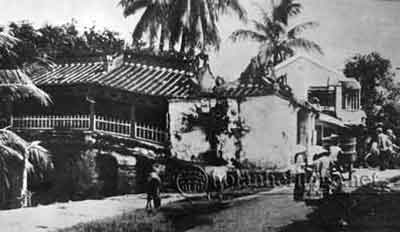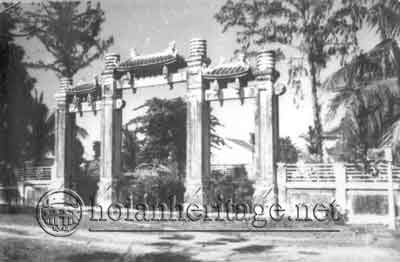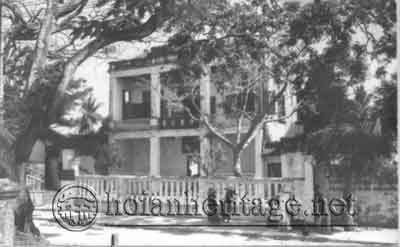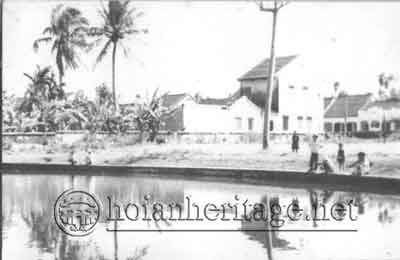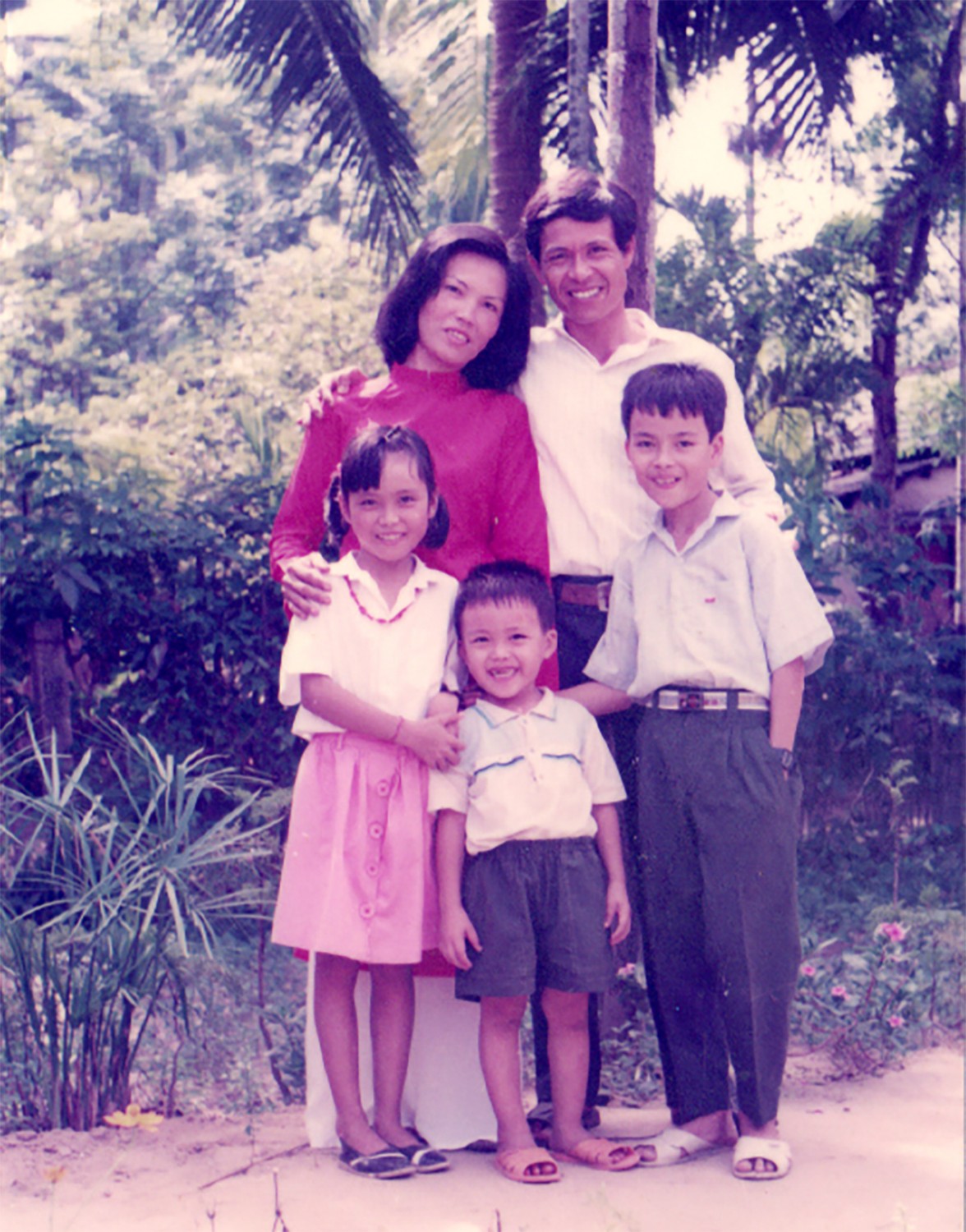Hoi An World Cultural Heritage Conservation Center
Looking back at the process of preserving the heritage of Hoi An ancient town since the 80s of the last century and suggesting some priorities for the coming time
1. Looking back at the process of preserving the heritage of Hoi An ancient town from the 80s to the present
Hoi An Ancient Town has been widely known for a long time, but it has only been recognized as an urban heritage that needs to be preserved since 1982. This historical milestone is related to the activities of the Polish - Vietnamese Subcommittee on the restoration of Cham cultural relics from 1980 to the mid-90s of the last century.
During the early working period of the Subcommittee in Quang Nam - Da Nang, Mr. Nguyen Dinh An, Director of the Department of Culture - Information and Mr. Ho Hai Hoc, Deputy Director of this Department, repeatedly mentioned to the expert group about Hoi An Ancient Town and invited the group to visit.
On the first day off in March 1982, Dr. Karol Majewski and Architect. Kazimierz Kwiatkowski (Kazik), together with the author of this article, who was then the Director of the Central Monuments Preservation and Restoration Workshop under the Ministry of Culture and Information, visited Hoi An town. After the survey, the delegation worked with the town leaders, including Mr. Vo Hien - Secretary, Mr. Phan Trung Thu and Mr. Quang Ba Hung, Chairman and Vice Chairman of the town.
Polish experts assessed Hoi An ancient town as a relic, an extremely rare urban heritage, which needs to be preserved and promoted in terms of tourism. They affirmed that Hoi An will become rich through tourism.
With experience in preserving ancient urban areas in their country, they expressed their willingness to start researching the preservation of the ancient town, outside the plan of the Subcommittee and without asking for any remuneration. For nearly ten years, the Chief Architect of the Cham Tower Restoration Team, Kazimierz Kwiatkowski, together with architect Rychard Drygallo and many technical staff of the Central Monuments Preservation and Restoration Workshop, worked outside of the contract, receiving only food and rest allowances from the Town People's Committee. The technical staff of the Central Monuments Preservation and Restoration Workshop continued to coordinate with local monument management staff until the late 2000s. It is worth mentioning the architects who worked here for a long time: Le Thanh Vinh, Pham Thanh Quang, Tran Quoc Tuan, Hoang Dao Cuong, Dang Khanh Ngoc, Nguyen Hong Son, Nguyen Ba Tuan, Pham Hoai Nam, Vu Huu Minh, archaeologist Nguyen Hong Kien, etc.
Hoi An Ancient Town has been widely known for a long time, but it has only been recognized as an urban heritage that needs to be preserved since 1982. This historical milestone is related to the activities of the Polish - Vietnamese Subcommittee on the restoration of Cham cultural relics from 1980 to the mid-90s of the last century.
During the early working period of the Subcommittee in Quang Nam - Da Nang, Mr. Nguyen Dinh An, Director of the Department of Culture - Information and Mr. Ho Hai Hoc, Deputy Director of this Department, repeatedly mentioned to the expert group about Hoi An Ancient Town and invited the group to visit.
On the first day off in March 1982, Dr. Karol Majewski and Architect. Kazimierz Kwiatkowski (Kazik), together with the author of this article, who was then the Director of the Central Monuments Preservation and Restoration Workshop under the Ministry of Culture and Information, visited Hoi An town. After the survey, the delegation worked with the town leaders, including Mr. Vo Hien - Secretary, Mr. Phan Trung Thu and Mr. Quang Ba Hung, Chairman and Vice Chairman of the town.
Polish experts assessed Hoi An ancient town as a relic, an extremely rare urban heritage, which needs to be preserved and promoted in terms of tourism. They affirmed that Hoi An will become rich through tourism.
With experience in preserving ancient urban areas in their country, they expressed their willingness to start researching the preservation of the ancient town, outside the plan of the Subcommittee and without asking for any remuneration. For nearly ten years, the Chief Architect of the Cham Tower Restoration Team, Kazimierz Kwiatkowski, together with architect Rychard Drygallo and many technical staff of the Central Monuments Preservation and Restoration Workshop, worked outside of the contract, receiving only food and rest allowances from the Town People's Committee. The technical staff of the Central Monuments Preservation and Restoration Workshop continued to coordinate with local monument management staff until the late 2000s. It is worth mentioning the architects who worked here for a long time: Le Thanh Vinh, Pham Thanh Quang, Tran Quoc Tuan, Hoang Dao Cuong, Dang Khanh Ngoc, Nguyen Hong Son, Nguyen Ba Tuan, Pham Hoai Nam, Vu Huu Minh, archaeologist Nguyen Hong Kien, etc.
 Some pictures of Architect. Kazimierz Kwiatkowski / Hoi An Center for Cultural Heritage Management and Preservation
Some pictures of Architect. Kazimierz Kwiatkowski / Hoi An Center for Cultural Heritage Management and PreservationAt this stage, for the first time in our country, the research and conservation work for an urban heritage has been carried out in a fundamental and scientific manner, creating a solid foundation for the next roadmap. That is:
- Survey, record, and comprehensively evaluate according to scientific and professional criteria, the ancient core area of Hoi An town, including determining the components of the heritage quarter; determining the types of architectural works, characteristics - age and value; determining the conservation status and technical status; behavioral directions in conservation and restoration, in promoting the effects, ...
- Building a detailed master map of the ancient urban core structure; the distribution of architectural works and spatial organization; recording the locations of architectural works of different values according to the first classification conducted; planning strictly protected areas and transitional areas; drawing the appearance of the main streets, ...
- Constructing more than thirty projects to restore typical architectural works, including houses, communal houses, pagodas, temples, assembly halls, ... with hundreds of drawings (currently kept at the Institute for Monuments Conservation). Constructing the first planning and technical and economic justification for the preservation of the old town.
- Carrying out the first restoration in Hoi An of the relics of the Japanese Covered Bridge and house number 100 on Tran Phu Street.
- Coordinating the organization of the first national workshop on Hoi An Ancient Town in 1985 and the international workshop in 1990.
Japanese experts continued the research work on the preservation of Hoi An, together with technical staff of the Central Monuments Design and Restoration Center (formerly the Central Monuments Preservation and Restoration Workshop) in the following years.
After more than 40 years of research and conservation of urban heritage - Hoi An heritage urban, we can confidently affirm: Hoi An heritage urban has been and is being maintained, preserved intact and firmly, in the body of Hoi An city that is developing organically, opening up the prospect of building Hoi An in the 21st century into a historical - ecological urban area, with a very unique position in the system of Vietnamese urban areas.
Specifically, it is necessary to note:
- The structure and appearance of the ancient core of the city are maintained almost safely, with almost no changes, in terms of organization and spatial morphology - landscape, the unimpairedness of architectural types and their appearance characteristics.
- The only natural and suitable choice for the maintenance and continued development: the model of social - residential community activities, is tourism and service economy, this is the second way to preserve this easily disappearing heritage.
- The city has effectively implemented urban management regulations, ancient town heritage management, for a long time, with the peaceful acceptance of the community. Along with that, there is the effective operation of heritage management and urban management agencies.
- Hoi An city today, many times larger, is planned and built in a soft transformation from the core - the center of the ancient town, without creating contrasts or challenges for it. Maintaining the macro balance: ancient town - river elements - agricultural suburbs - coast.
The major restoration of the Japanese Covered Bridge relic can be considered a success, demonstrated by the thoroughness in dissecting the technical status of the relic; in the design documents for reinforcement and restoration, with expert consultation; in compliance with the principles and methods of restoration of wooden architectural relics that have been summarized nationwide. In particular, the restoration of this relic is carried out in the open, which is completely suitable for a place where visitors can hardly be indifferent to what is happening with a first-class relic of Hoi An. From here, we can rest assured in the strength of the local professional force in the restoration of the relic.
2. Some suggestions for preserving and promoting Hoi An Heritage City in the coming time
Hoi An, with its resources (this term is more suitable for Hoi An) of urban heritage and with today's development practices, has enough basis to become one of the few cities that are completely balanced, modernized in the natural continuity and symbiosis of historical - contemporary and future elements. That is a particularly rare opportunity that we need to recognize, avoiding being drawn into the mass modernization - globalization cascade, which easily loses or fades the "I" of each city. The faster we progress, the more we have to care about retaining what is unique, what is quintessential, what creates the "name" for the place we live, for the city that we are proud to be a citizen of.
For Hoi An, heritage preservation must be naturally linked to continued development, forming a stream, a chain of continuity in both the urban body and its soul. Until now, looking closely, we realize that this city, rarely, has maintained the flow - the natural transformation like that, from ancient - old to advanced, from small scale to much larger scale; from a clustered urban area to an urban area opening up to the outskirts, quiet and spacious... Therefore, talking about the success and preservation of the ancient town's heritage, we must also talk about that success in expanding and modernizing Hoi An today.
2.1 On the development of the old Hoi An urban architecture fund
The phrase “development of continuity” refers to the seamless connotation: Maintain - preserve - renovate - upgrade - adapt - modernize. Depending on the structure of the urban architecture fund, we can apply or partially, or combine, or fully the above connotations.
Based on the open recognition of heritage, it is advisable to include the established ancient core area, the streets and the expanded street areas in the modern period. In general, the architecture of the ancient core area and the expanded area from the late 19th century to the mid-20th century, creating a unity in nature and visuality. Phan Boi Chau Street is an example, with the appearance of the street restaurant architecture almost identical, combining colonial architectural elements mixed harmoniously with the urban architecture of the provinces. With this modern architectural area, flexible management and renovation regulations should be put in place, meeting both the requirements of preservation and renovation, and even the requirements of construction. It is time to consider combining conservation and renovation, adaptive renovation and upgrading the quality of residence for hundreds of houses - houses in the old core and old areas. Especially the core parts of the Old Quarter. Here, in addition to maintaining traditional architectural features, it is necessary to renovate and upgrade the quality and aesthetics of small spaces, and to facilitate old houses, most of which are degraded, according to the requirements of modern urban life. We have the ability to renovate and preserve architectural works of special value. However, to preserve hundreds of houses, most of which are valuable in terms of creating the overall unity of the heritage city, it is necessary to study ways of restoration and renovation that are feasible for the people in terms of technology, finance, materials, and preferences... Just calculating, to maintain hundreds of old houses, tens of thousands of cubic meters of good wood are needed. In addition, where does the funding come from? How much of it can the budget bear? If it is only limited to regulations and advocacy, then maintaining the old architectural fund that is not in the category of classification is completely impossible.
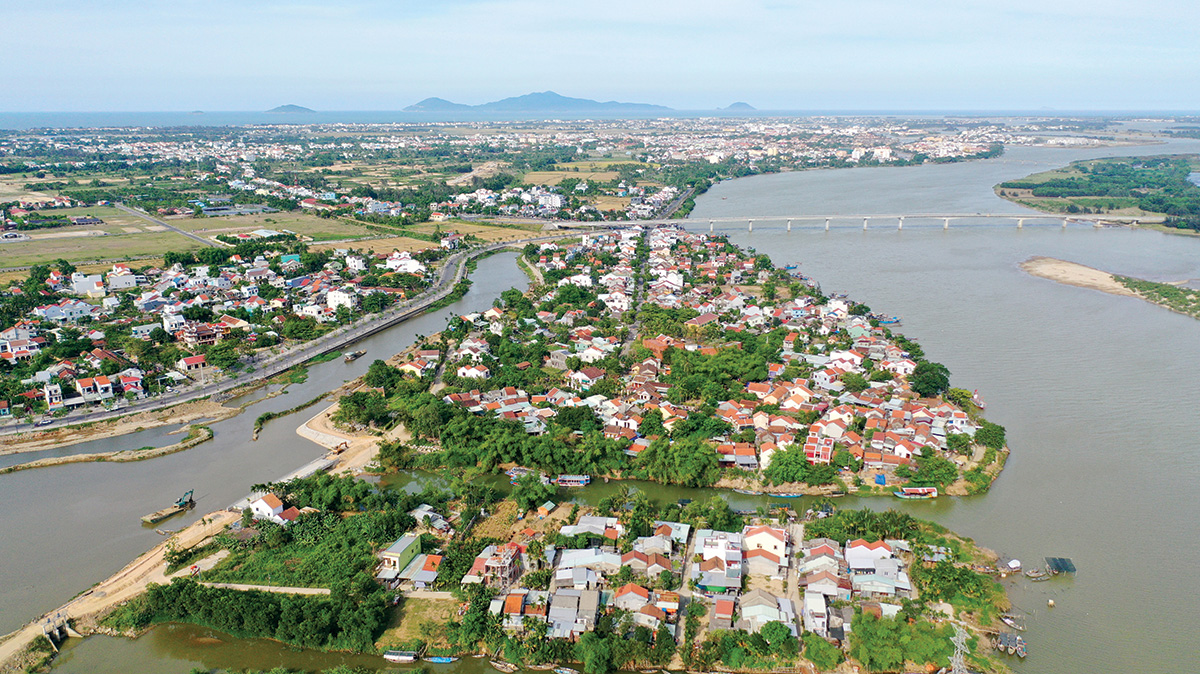 Hoi An Ancient Town from above/ Quang Ngoc
Hoi An Ancient Town from above/ Quang Ngoc 2.2 The issue of sustainably maintaining the cellular connection between the traditional architectural fund and the life of the local community
The outstanding and extremely rare values of the heritage of Hoi An Ancient Town lie there. In many places, people are forced to create - imitate the old quarters, then create corresponding living and business models, to serve tourism. It is a form of modeling, a visual illustration of the past that has completely disappeared. More than 40 years ago, we discovered for ourselves a magical ancient town of Hoi An, a small city, containing within itself a living heritage: it is an old body, still preserving both body and soul, surviving, contrary to the laws of nature.
Now, the unification, like a phenomenon, of architecture and population has revealed cracks, filled with syndromes.
As for maintaining the old - ancient architectural asset fund, we can rest assured. However, in terms of the lives of the local community, there are changes that have begun to be recognized. The cause is the socio-economic development, especially the service-tourism economy. The booming development has created a great attraction for this city, which used to be just a town. Many people in big cities buy houses on main streets, open large and luxurious shops, more or less different from the modest business scale of the old town. Many people in the old town have moved to live on the outskirts, working as salesmen in shops and restaurants owned by owners from far away. Perhaps, there is a change of blood here.
It is not too late, we should take care of the values, traditions, and unique cultural features of the old town's citizens. That is the second part of the task of preserving the heritage resources of Hoi An Ancient Town.
2.3 On the continued development of Hoi An city
In the framework of this article, the author mentions the preservation of urban heritage in connection with the continued development situation. This connection is the great policy in the cause of preserving the cultural - historical - material and social foundation of Hoi An city in the long term.
Let me repeat: The continued development of ancient cities is first of all the soft transformation between urban components of different historical periods, the soft transformation between urban structures and the existing natural environment. Soft transformation means maintaining the development chain in evolution, not only by chronology, but also by the succession of architectural funds of different periods, without creating historical residues, contrasts of an annihilating nature. Fortunately, up to this point, Hoi An is such an urban area.
There is a concern, even panic: In a recent planning, people designed an elevated tramway running through Cam Nam ward!
Hopefully, Hoi An people and those who love Hoi An from afar will treat this internationally famous urban area in a way that is uniquely suitable for it.
Time will show that it is possible to live peacefully and happily in a place that possesses unique Heritage resources./.
The outstanding and extremely rare values of the heritage of Hoi An Ancient Town lie there. In many places, people are forced to create - imitate the old quarters, then create corresponding living and business models, to serve tourism. It is a form of modeling, a visual illustration of the past that has completely disappeared. More than 40 years ago, we discovered for ourselves a magical ancient town of Hoi An, a small city, containing within itself a living heritage: it is an old body, still preserving both body and soul, surviving, contrary to the laws of nature.
Now, the unification, like a phenomenon, of architecture and population has revealed cracks, filled with syndromes.
As for maintaining the old - ancient architectural asset fund, we can rest assured. However, in terms of the lives of the local community, there are changes that have begun to be recognized. The cause is the socio-economic development, especially the service-tourism economy. The booming development has created a great attraction for this city, which used to be just a town. Many people in big cities buy houses on main streets, open large and luxurious shops, more or less different from the modest business scale of the old town. Many people in the old town have moved to live on the outskirts, working as salesmen in shops and restaurants owned by owners from far away. Perhaps, there is a change of blood here.
It is not too late, we should take care of the values, traditions, and unique cultural features of the old town's citizens. That is the second part of the task of preserving the heritage resources of Hoi An Ancient Town.
2.3 On the continued development of Hoi An city
In the framework of this article, the author mentions the preservation of urban heritage in connection with the continued development situation. This connection is the great policy in the cause of preserving the cultural - historical - material and social foundation of Hoi An city in the long term.
Let me repeat: The continued development of ancient cities is first of all the soft transformation between urban components of different historical periods, the soft transformation between urban structures and the existing natural environment. Soft transformation means maintaining the development chain in evolution, not only by chronology, but also by the succession of architectural funds of different periods, without creating historical residues, contrasts of an annihilating nature. Fortunately, up to this point, Hoi An is such an urban area.
There is a concern, even panic: In a recent planning, people designed an elevated tramway running through Cam Nam ward!
Hopefully, Hoi An people and those who love Hoi An from afar will treat this internationally famous urban area in a way that is uniquely suitable for it.
Time will show that it is possible to live peacefully and happily in a place that possesses unique Heritage resources./.
Author: Prof.Dr.Architect. Hoang Dao Kinh
Source: Hoi An Center for Cultural Heritage Management and Preservation
Newer articles
Older articles
